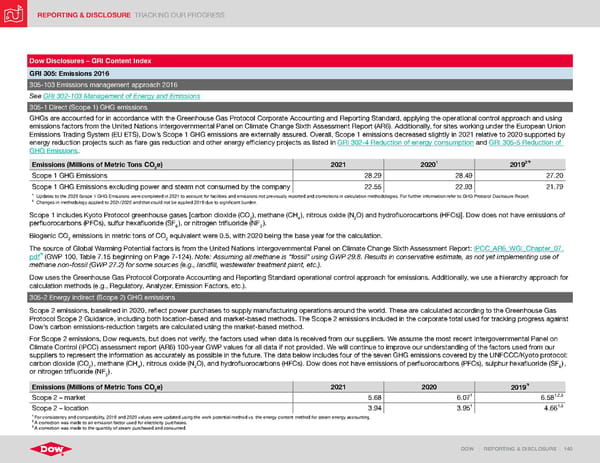REPORTING & DISCLOSURE TRACKING OUR PROGRESS DOW | REPORTING & DISCLOSURE | 140 Dow Disclosures – GRI Content Index GRI 305: Emissions 2016 305-103 Emissions management approach 2016 See GRI 302-103 Management of Energy and Emissions 305-1 Direct (Scope 1) GHG emissions GHGs are accounted for in accordance with the Greenhouse Gas Protocol Corporate Accounting and Reporting Standard, applying the operational control approach and using emissions factors from the United Nations Intergovernmental Panel on Climate Change Sixth Assessment Report (AR6). Additionally, for sites working under the European Union Emissions Trading System (EU ETS), Dow’s Scope 1 GHG emissions are externally assured. Overall, Scope 1 emissions decreased slightly in 2021 relative to 2020 supported by energy reduction projects such as flare gas reduction and other energy efficiency projects as listed in GRI 302-4 Reduction of energy consumption and GRI 305-5 Reduction of GHG Emissions . Emissions (Millions of Metric Tons CO 2 e) 2021 2020 1 2019 2 Scope 1 GHG Emissions 28.29 28.49 27.20 Scope 1 GHG Emissions excluding power and steam not consumed by the company 22.55 22.93 21.79 1 Updates to the 2020 Scope 1 GHG Emissions were completed in 2021 to account for facilities and emissions not previously reported and corrections in calculation methodologies. For further information refer to GHG Protocol Disclosure Report. 2 Changes in methodology applied to 2021/2020 and that could not be applied 2019 due to significant burden. Scope 1 includes Kyoto Protocol greenhouse gases [carbon dioxide (CO 2 ), methane (CH 4 ), nitrous oxide (N 2 O) and hydrofluorocarbons (HFCs)]. Dow does not have emissions of perfluorocarbons (PFCs), sulfur hexafluoride (SF 6 ), or nitrogen trifluoride (NF 3 ). Biogenic CO 2 emissions in metric tons of CO 2 equivalent were 0.5, with 2020 being the base year for the calculation. The source of Global Warming Potential factors is from the United Nations Intergovernmental Panel on Climate Change Sixth Assessment Report: IPCC_AR6_WGI_Chapter_07. pdf (GWP 100, Table 7.15 beginning on Page 7-124). Note: Assuming all methane is “fossil” using GWP 29.8. Results in conservative estimate, as not yet implementing use of methane non-fossil (GWP 27.2) for some sources (e.g., landfill, wastewater treatment plant, etc.). Dow uses the Greenhouse Gas Protocol Corporate Accounting and Reporting Standard operational control approach for emissions. Additionally, we use a hierarchy approach for calculation methods (e.g., Regulatory, Analyzer, Emission Factors, etc.). 305-2 Energy indirect (Scope 2) GHG emissions Scope 2 emissions, baselined in 2020, reflect power purchases to supply manufacturing operations around the world. These are calculated according to the Greenhouse Gas Protocol Scope 2 Guidance, including both location-based and market-based methods. The Scope 2 emissions included in the corporate total used for tracking progress against Dow’s carbon emissions-reduction targets are calculated using the market-based method. For Scope 2 emissions, Dow requests, but does not verify, the factors used when data is received from our suppliers. We assume the most recent Intergovernmental Panel on Climate Control (IPCC) assessment report (AR6) 100-year GWP values for all data if not provided. We will continue to improve our understanding of the factors used from our suppliers to represent the information as accurately as possible in the future. The data below includes four of the seven GHG emissions covered by the UNFCCC/Kyoto protocol: carbon dioxide (CO 2 ) , methane (CH 4 ) , nitrous oxide (N 2 O), and hydrofluorocarbons (HFCs). Dow does not have emissions of perfluorocarbons (PFCs), sulphur hexafluoride (SF 6 ) , or nitrogen trifluoride (NF 3 ). Emissions (Millions of Metric Tons CO 2 e) 2021 2020 2019 Scope 2 – market 5.68 6.07 1 6.58 1,2,3 Scope 2 – location 3.94 3.95 1 4.66 1,3 1 For consistency and comparability, 2019 and 2020 values were updated using the work potential method vs. the energy content method for steam energy accounting. 2 A correction was made to an emission factor used for electricity purchases. 3 A correction was made to the quantity of steam purchased and consumed.
 ESG Report | Dow Page 139 Page 141
ESG Report | Dow Page 139 Page 141